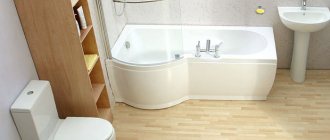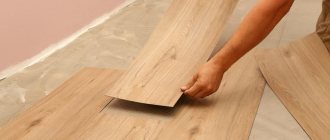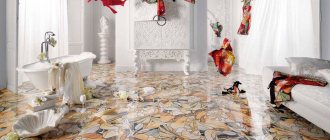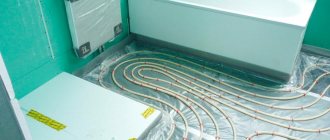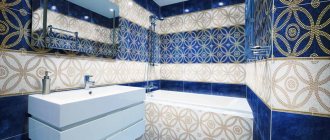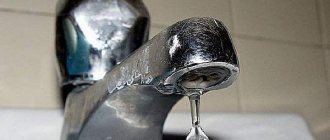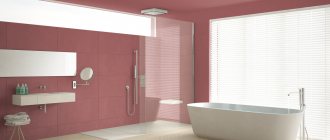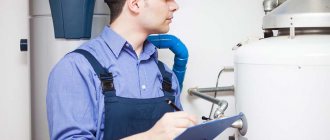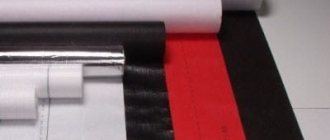Ceramic tiles are the optimal material for finishing a bathroom due to their durability and reliability, as well as ease of maintenance. That is why almost every bathroom is tiled. But sometimes unpleasant situations occur, such as peeling or even destruction of one or more tiles. What to do in such situations when the tiles in the bathroom have come off, the reasons and methods for eliminating such a finishing defect are discussed in this article.
Reasons for old tiles peeling off
The reliability of tiles does not guarantee the durability of the entire finish.
During installation, the master may overlook many points:
- The presence of voids between the tile and the load-bearing surface - if this figure is more than 10 percent of the entire joint area, then the tile collapses;
- Uneven load-bearing base - mainly concerns installation on a skewed wall;
- Poor adhesion - occurs due to the lack of minor roughness on the supporting base (for example, walls can be wooden or plastic);
- Poor quality work with glue - implies both the choice of a cheap adhesive composition and the lack or excess of its volume when applied;
- Overmoistening - occurs due to poor-quality seams or the use of a low-quality adhesive mixture;
- Mechanical loads indicate improper use of furniture, shrinkage of walls, or intensive repairs in the adjacent room.
Checking the supporting base and the backing layer of the tile allows you to find out what caused the collapse or displacement of a separate fragment of the entire finish. If mold and moisture are detected, the ventilation system will have to be updated.
The displacement of the tile indicates incomplete shrinkage or tilting of the surface of the supporting base. The voids are an excuse to strip off the old layer and apply a fresh adhesive mixture.
Results
The most effective way to eliminate peeling on tile cladding is to do everything possible to prevent this from happening. To do this, it is necessary to exercise maximum care when choosing a suitable adhesive composition. The same applies to the implementation of tile laying technology: all recommendations regarding operating temperature and base preparation must be carefully followed. In cases where tile peeling does occur, use one of the above-described methods to eliminate the problem.
The tile has come off, what to do: step-by-step instructions with photos and videos
bathroom ceramic tiles tiles floors wall renovation
Required Tools
Fragmentary wear and tear on the tile trim can easily turn into a major overhaul. Therefore, it is recommended to fasten fallen tiles quickly.
To do this you will need the following tools:
- Toothed, cap, regular and rubber spatulas;
- Rubber mallet;
- Chisel;
- Level;
- Paint brush;
- Mounting crosses;
- Sandpaper of different grain sizes;
- Brush and rags;
- Containers for working with the solution.
If corner tiles collapse and possibly crack, you will have to use a tile cutter. But before you take on the machine, you need to purchase tiles of the required series or the most similar analogue.
It is quite possible that you will have to wipe off the hardened layer of glue with a brush attached to an electric drill or hammer drill.
Waterproof drywall
Waterproof drywall
Waterproof drywall is good for sink areas and other areas where occasional splashes and high humidity would damage regular drywall. The sheets consist of a water-repellent gypsum core covered with waterproof paper. Like regular plasterboard, it is sold in sheets measuring 120 x 240 mm and 12 mm thick.
- is a good base for painting, wallpaper and tiles in places that are occasionally exposed to moisture, such as the kitchen and bathroom;
- inexpensive - about a fifth of the cost of other types of backing slabs (bases) for ceramic tiles.
- Not suitable as a base for tiles near bathtubs and showers.
Selecting consumables
In particular, we are talking about a substance that will be used to adhere the tiles to the wall-floor surface.
Today there are quite a lot of such consumables:
- Silicone sealants;
- Liquid Nails;
- Bulk solids;
- Cement mortar (not to be confused with adhesive mortar, which is prepared from bulk substances).
Cement mortar is a budget option, so it is suitable primarily for the restoration of flooring inside industrial and commercial premises.
Bulk compositions are an analogue of cement mortar. Their composition includes stabilizers and glue for fast and high-quality adhesion. Silicone sealants come in a gel or paste state that quickly hardens after application. The second advantage of such compositions is a high level of tightness.
All that remains is to choose products from recognized brands (eg Ceresit, Knauf, Unis). Liquid nails are the same silicone sealants. However, due to the small volume of the so-called. nails are used pointwise.
This approach saves mixture consumption, but degrades the quality of the clutch. However, for adding individual pieces of tiles, liquid nails are a suitable solution.
Cement board
Cement board
Cement board is the most durable, reliable base for arranging bathrooms, showers, floors and any other wet areas. It is made of cement and sand and reinforced with fiberglass mats on both sides so that moisture does not pass through. Typically the material is produced in the form of sheets measuring 90 x 150 cm and 12 mm thick. Other sizes are also available, including 6 or 8 mm thick.
- high resistance to moisture;
- strong and durable;
- some types can be used for outdoor work (depending on the manufacturer’s characteristics);
- An ideal surface for laying tiles on a thin layer of mortar.
- difficulty in finishing;
- at least 6-25 mm of edge support is required for proper fastening;
- A layer of plastic or other waterproof material is required underneath to protect the wood sheathing, which is not moisture resistant.
To contents
Restoration of old tiles
There are two types of fallen tiles - solid and cracked. Instead of the latter, it is recommended to use a solid analogue. The fact is that cracked tiles always have pores due to lost tile particles.
If this does not discourage installation, then you will have to:
- Create a form or supporting base for balanced joining of fragments with each other and their subsequent fastening to the wall;
- Clean each fragment from the reverse side;
- Clean and smooth the surface of the sections.
Working with solid tiles is quick. However, the grippy material behind it must also be removed. This is done by wetting the underside with warm water for 3-4 hours.
If the adhesive is difficult to remove with a brush, then instead of water you should use a 15% solution of citric acid or a 5% solution of acetone. You can also use either a household brush or fine-grained sandpaper to remove glue.
At what temperature should I lay tiles?
There is an optimal temperature range for laying ceramic tiles: for example, the best result can be obtained if work is carried out at a temperature of 18-24 degrees , but this does not mean that this cannot be done in other conditions, it’s just that the result will be worse the lower or higher the temperature from "ideal". If it is too low , the glue will take a long time to dry , and if it is high , the moisture will quickly evaporate, preventing the glue from setting .
Therefore, it is important to create an optimal microclimate in the room where work is carried out: in winter it is necessary to heat it using different heating methods, and in summer such work should be carried out in the morning or evening, when the temperature drops slightly. As for using an air conditioner to create the desired temperature, this solution to the problem should be abandoned due to excessive drying of the air in the room.
However, ensuring the optimal temperature for the process of laying ceramic tiles is one thing, but the further conditions in which the room will be operated are completely different. Therefore, for rooms where low temperatures are observed (dachas and other unheated buildings), it is better to use frost-resistant tiles. It is characterized by low porosity and low water absorption. Therefore, tiles made of granite, porcelain stoneware and clinker tiles are ideal for such rooms.
Preparing the base before laying new tiles
The surface of the walls or floor must also be cleaned of the remaining mixture.
This can be a primer, putty or hardened adhesive:
- When preserving the seams, it is necessary to carefully beat off the old grout with a chisel and mallet;
- Next, you will have to check the reliability of adhesion of adjacent tiles (if, when pressed, the fragments move, then it is recommended to clean the gaps and fill them with sealant);
- The next step is to clean the hardened dry mixture on the surface of the supporting base using a spatula, brush or sandpaper;
- Next, the surface is leveled with putty, cleaned of construction contaminants, degreased with a 10% soap solution and primed.
Some putty mixtures include a primer. The latter promotes reliable adhesion of the tiles.
If the load-bearing surface will be subject to fungal mold, it is recommended to add a fungicide to the primer solution. The primer can also be applied in two layers if the base tends to absorb moisture.
Restoration adhesive options
Is it possible to glue ceramics securely without harming your health? This question is asked by many people faced with such a need.
Adhesive compounds are one of the most common options for joining parts. They are presented on the market in a wide range and contain an adhesive substance. The scope of application of such products is the repair and reconstruction of products, ceramic dishes and decorative items made of ceramics and earthenware. These two materials are often combined, since the glue for one and the other is the same, which makes it universal.
Don't know what glue to use to glue ceramics? A good option is a mixture based on cyanoacrylate. This is the optimal combination of price and quality. You can buy superglue at any specialty store.
Among other common options for adhesives for ceramics, experts note the following:
- "Second".
- "Super moment."
- "Cyanopan."
- "Glue."
- "Force".
- "Monolith".
- "Elephant".
- "MARS" (imported waterproof glue for ceramics).
- PVA used to restore food-grade ceramic products. But this option is suitable only for those products whose surface is not varnished.
- F-2, BF-4 - for all types of ceramics.
Instructions for laying new tiles
The period of complete drying of the primer lasts up to 36 hours. If the base absorbs moisture, then 2-3 hours after applying the primer it is recommended to apply a second similar layer.
After the finishing layer has dried, you can begin installing the peeled tiles:
- First you need to prepare a working solution in a container, then let it sit for 15 minutes (silicone sealant and liquid nails are applied in a ready-made state);
- Next, using a spatula, a solution is applied to the center of the back side of the tile, after which the latter is distributed over the entire tile (if the fragment does not belong to the pendulum row, then the mixture is applied directly to the base);
- The next step is to level the layer and create grooves in it using a regular and comb spatula, respectively;
- The tile is carefully inserted into the empty opening and easily pressed with hands from four sides;
- Mounting crosses are inserted into the seams.
To position the tiles correctly, you must also use a level. When using sealants and liquid nails, the working substance is distributed over the entire surface of the tile or base, depending on the row of finishes. To do this, it is enough to apply the viscous substance in several places and rub it with a sponge or a regular roller.
Fiberglass gypsum board
Fiberglass gypsum board
Fiberglass gypsum board has performed well in damp areas, including bathrooms, but not in areas that are constantly exposed to moisture. The sheets are made from moisture-resistant gypsum impregnated with silicone, reinforced on both sides with fiberglass mats. The side on which the tiles will be laid is sealed with a waterproof coating. Sheets usually have a size of 120 x 150 cm and a thickness of 12 mm. However, tile sellers also offer 6 mm thick sheets.
- waterproof coating; no additional moisture-resistant layer is needed;
- Lighter in weight than cement board;
- Easier to cut and secure than cement board.
- softens if water seeps through seams or gets behind a waterproof surface;
- not suitable for some types of floor tiles (see manufacturer's specifications);
- Fiberglass mats cause irritation on unprotected skin. When cutting and installing slabs, wear long sleeves, gloves, safety glasses and a dust mask.
Grouting joints
Cement mortar takes the longest to dry. But if an adhesive mixture or sealant was used instead, the drying period is reduced to 12 hours.
After the working mixture has completely hardened, you can begin grouting the joints:
- First, you need to clear future seams from crosses and residues of the mixture (to remove the latter, use a toothbrush or a stationery knife);
- Next, the empty tile seams are wiped with a damp sponge;
- The next step is to apply the grout mixture to the edge of the rubber spatula;
- Using smooth movements, apply the grout to the seams until they are filled;
- After 40-50 minutes, the dried grout remaining on the surface of the tile is removed with a damp sponge.
The sponge should be soft and cellulose. The absorbed grout must be constantly removed into a container with water to keep the sponge clean.
Otherwise, grout particles may leave scratches on the tiles.
Method 2. Based on shellac and turpentine
Another option for gluing ceramics.
Ingredients:
- turpentine;
- light shellac.
Combine the ingredients and place the container over low heat. The mixture requires cooking until the shellac has completely melted. During preparation, the glue is constantly stirred until a homogeneous consistency is obtained. This composition takes longer to harden, so it can be prepared as a backup option. The mixture is allowed to cool and, divided into portions, placed in storage or used to treat cracks or chips in the toilet bowl.
As necessary, it is heated and applied in a thin layer to the surfaces to be bonded. As a result, the reinforced parts are compressed, which ensures their tight adhesion. The resulting glue residue should be wiped off immediately.

